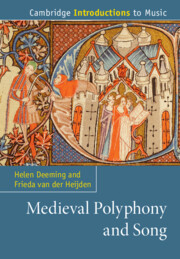Book contents
- Cambridge Introductions to Music
- Medieval Polyphony and Song
- Copyright page
- Dedication
- Contents
- Figures
- Tables
- Boxes
- Music Examples
- Acknowledgements
- Chapter 1 Introduction and Historical Outline
- Chapter 2 Monastic Centres in the Early Middle Ages
- Chapter 3 Court and Cloister in Aquitaine and Occitania
- Chapter 4 Paris: City, Cathedral, and University
- Chapter 5 Courts and Cities in Northern France
- Chapter 6 Scribes, Scholars, and Secretaries in Fourteenth-Century France
- Chapter 7 England after the Norman Conquest
- Chapter 8 On the Shores of the Mediterranean: Italy, Sicily, and the Iberian Peninsula
- Chapter 9 The German- and Dutch-Speaking Lands
- Chapter 10 Medievalisms: Modern Encounters with Medieval Polyphony and Song
- Glossary
- Bibliography
- Discography
- Index
- Cambridge Introductions to Music
- References
Chapter 6 - Scribes, Scholars, and Secretaries in Fourteenth-Century France
Published online by Cambridge University Press: 27 April 2023
- Cambridge Introductions to Music
- Medieval Polyphony and Song
- Copyright page
- Dedication
- Contents
- Figures
- Tables
- Boxes
- Music Examples
- Acknowledgements
- Chapter 1 Introduction and Historical Outline
- Chapter 2 Monastic Centres in the Early Middle Ages
- Chapter 3 Court and Cloister in Aquitaine and Occitania
- Chapter 4 Paris: City, Cathedral, and University
- Chapter 5 Courts and Cities in Northern France
- Chapter 6 Scribes, Scholars, and Secretaries in Fourteenth-Century France
- Chapter 7 England after the Norman Conquest
- Chapter 8 On the Shores of the Mediterranean: Italy, Sicily, and the Iberian Peninsula
- Chapter 9 The German- and Dutch-Speaking Lands
- Chapter 10 Medievalisms: Modern Encounters with Medieval Polyphony and Song
- Glossary
- Bibliography
- Discography
- Index
- Cambridge Introductions to Music
- References
Summary
Chapter 6 begins in the same geographical area as chapter 5, examining the changes in music and especially in musical notation in the fourteenth century that are termed the Ars Nova. The careers of the musicians Philippe de Vitry and Guillaume de Machaut - both encompassing roles in royal or noble administration, and ecclesiastical positions - contrast markedly with the lives of the thirteenth-century trouvères. New approaches to musical notation both responded to and facilitated greater rhythmic complexity in both Latin polyphony and vernacular song, and these elements were elaborated even further at the end of the century by composers of the Ars Subtilior. The technique of isorhythm offered a way for polyphonic pieces to be structured along primarily musical lines, and composers made the most of the opportunities it provided to create subtle and sophisticated forms. Against a backdrop of climate emergency and a great pandemic (the Black Death), political and religious upheaval in the form of the Hundred Years’ War and the Avignon papacy, musicians used satire and allegory to shine a critical light on their society and its leaders.
Keywords
- Type
- Chapter
- Information
- Medieval Polyphony and Song , pp. 115 - 138Publisher: Cambridge University PressPrint publication year: 2023

